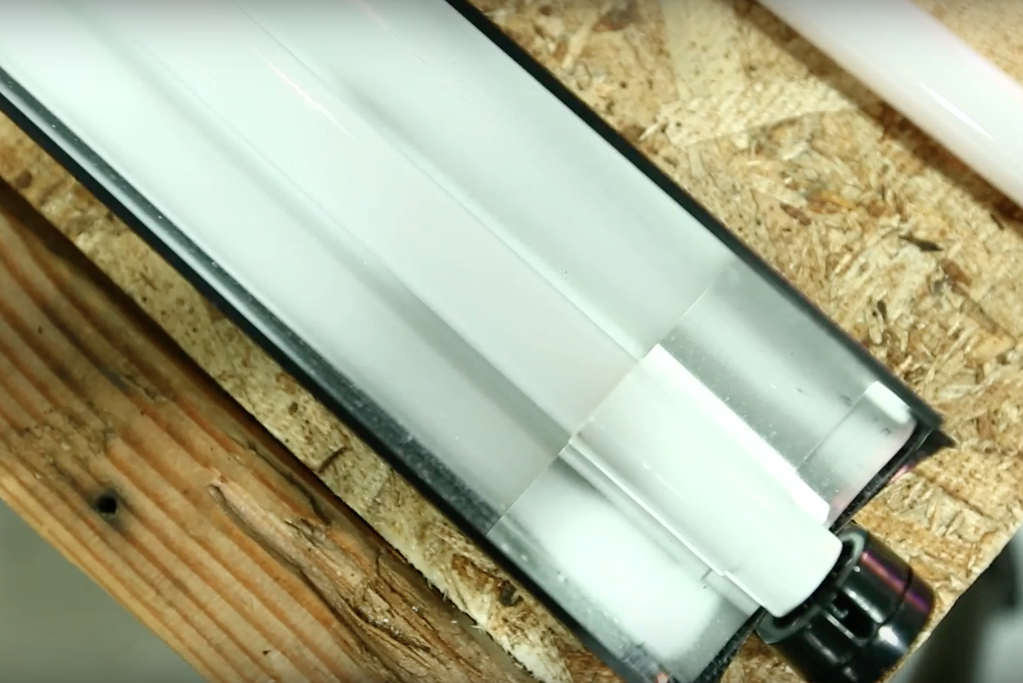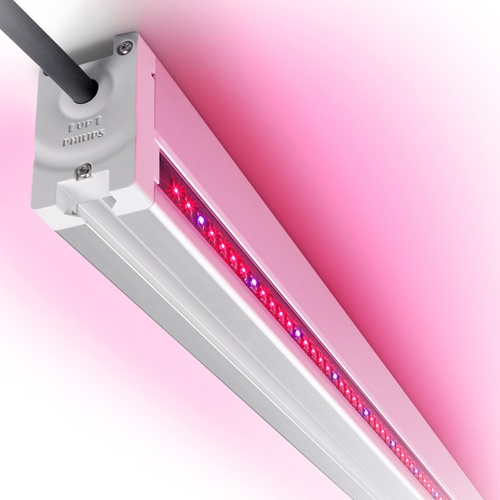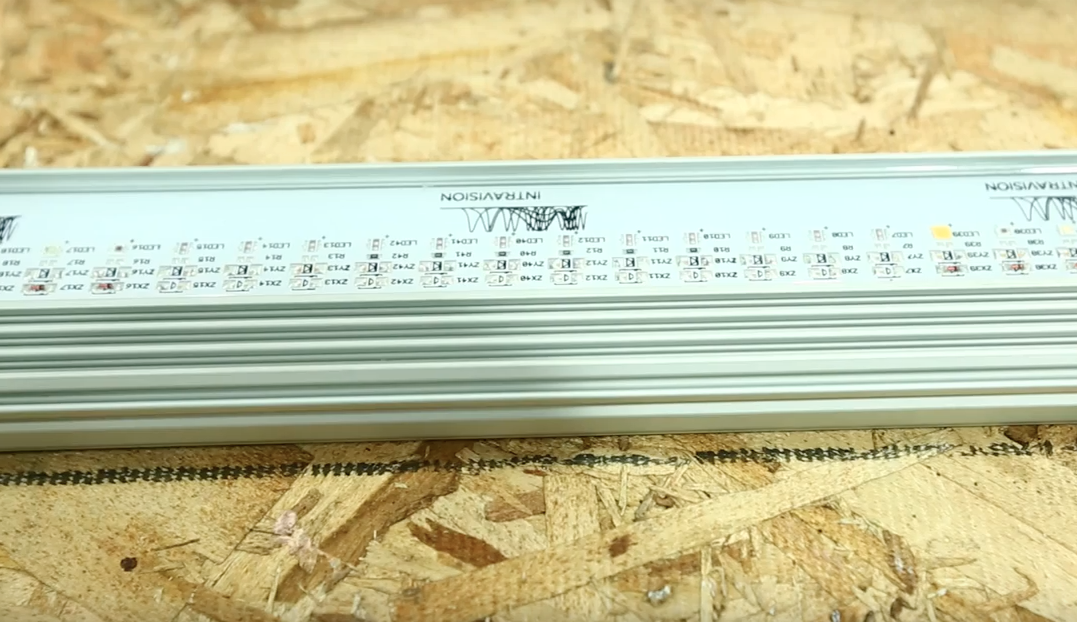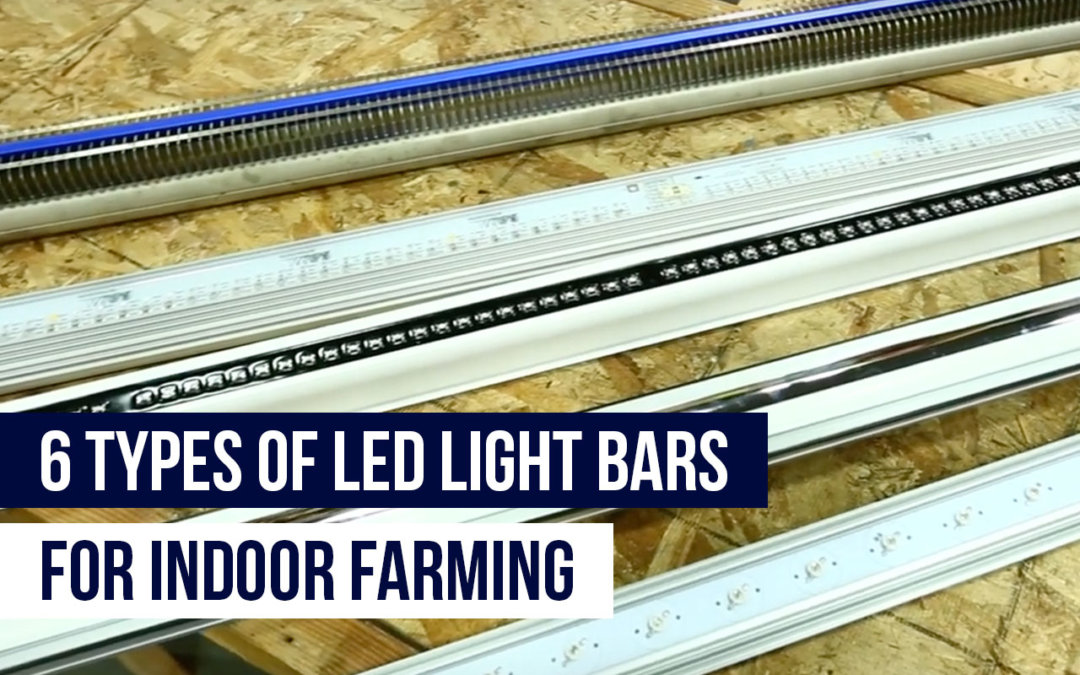LED light bars give indoor growers great coverage and utility
LED light bars are one of the top options for indoor growers due to their utility and coverage.
Whereas fixtures can be bulky and difficult to fit into tight spaces, light bars are generally longer and more slender overall. This means that they fit great into high-density production facilities like most vertical farmers are using, and the increased length of the bar makes coverage more manageable and dispersed.
In this post, you’ll learn about six different types of LED light bars, their various features and benefits, and some of the issues light bars can present to farmers.
A quick note on heat!
As with all artificial lighting, LED lights produce heat.
Your ability to manage this excess heat in your growing environment could mean the difference between a healthy, productive farm and a disease-infested, humid hell of a production facility.
This excess heat also has a profound impact on the life of your LED lights. The hotter the lights, the shorter the lifespan which makes the decision to invest in the right lights even more crucial. As you can imagine, there aren’t many growers who have the budgets to replace their lights each year!
Read more: The Modern Farmer’s Guide to Artificial Lighting
So how do light bars mitigate heat?

Heat sinks usually consist of extruded metal attached to the opposite side of a LED light bar.
As you’ll see in the examples below, most LED light bars are equipped with what are called “heat sinks”. Unlike LED fixtures that use active cooling like fans, bars are often manufactured with extra extruded pieces of aluminum that increase the surface area of the light bar and help pull heat from the face of the plants.
Of course, there is a limit to how much surface area can be gained with extrusions, and for that reason, most light bars are about half the wattage of fixtures. While not always the case, one drawback to using light bars is that they are usually lower voltage than fixtures. More on why that matters below, so keep reading!
All that to say the light bar form factor is a great choice for a wide range of growers but benefits vertical plane farmers especially due to its length and coverage. We’re also optimistic that as the industry matures, we’ll see more innovations in heat removal.
6 types of LED light bars
Here are a few of the light bar products on the market today. This list is not exhaustive and is in no particular order.
1) LEDs from third-party manufacturers
Although there are some really nice LEDs being made in China these days, we don’t typically recommend using Chinese light bars because there are just too many unknowns. Things like quality, warranty, and reliability are just a few of the factors we would be wary of when working with a 3rd party manufacturer.
While we’ve had some great experiences with these types of direct-to-consumer lights in our own indoor farming trials, we always encourage commercial farmers to work with trusted brands like the ones below!
2) Transcend Lighting LEDs
Transcend Lighting is a startup company doing some cool stuff with LED bulbs. The one in the video looks like a T5 and fits into a regular T5 fixture because it’s an LED bulb (the diodes are encased in the glass bulb).

The cool thing about this is that you can replace an old T5 bulb with a new LED one in the same fixture. There’s a heat sink on the back and they have a propriety coding technology to get good spectrum.
Learn more about Transcend LEDs here.
3) Phillips Green Power LEDs
 Phillips creates some long-lasting LED lighting technology. They’re a quality product but tend to be on the more expensive side compared to similar tech out there.
Phillips creates some long-lasting LED lighting technology. They’re a quality product but tend to be on the more expensive side compared to similar tech out there.
The Green Power product line includes special bars that are tailored to the grower’s specific application. Their various lights include inter-lighting, top-lighting, research testing, and even tissue culture.
If you’re interested in exploring Phillips products, the great folks at HortAmericas can help you out.
4) General Electric LEDs
GE has been in the lighting game for a long time but has recently made a serious push into the horticultural lighting sector to help indoor farmers reduce electricity usage with wavelength-optimized grow lights.

While popular in Japanese “plant factories“, GE’s lights made a big debut on the world’s stage at the USA Pavilion during the 2015 World’s Fair thanks to Biber Architects who created a stunning display of ZipGrow chandeliers inside the pavilion. (See photo above)
A few interesting items to note about the GE’s LED light bar is that it’s completely waterproof(!) and they’ve designed the shroud to produce diffused light. Most LEDs give direct light, but plants actually do better with diffused (scattered) light because it eliminates shadowing.
Fun fact: The reason ZipGrow Towers are white also has to do with reflecting diffused light vs. direct light.
5) Intravision Blade LEDs
Intravision is a fast-moving LED technology company hailing from Canada creating narrow bandwidth and colored lights for a wide variety of applications both in and beyond horticulture.

Their “Blades” use a powerful combination of a two-sided design with a sturdy, yet sleek structure making them a great option for vertical plane growers and those seeking to use artificial light for interlighting applications like growing tomatoes.
They’ve held up very well in our own indoor vertical farming trials and are being used in vertical farming applications throughout Canada, including Modular Farms.
6) The LumiBar LED from LumiGrow
 LumiGrow’s LumiBar is one of the few high voltage bars on the market. At 185 watts, this high tech LED bar puts out over 50 more watts than low voltage options.
LumiGrow’s LumiBar is one of the few high voltage bars on the market. At 185 watts, this high tech LED bar puts out over 50 more watts than low voltage options.
Why is that important?
Because high voltage lights give growers higher light intensities with fewer bars compared to low voltage options. While more accessible for more beginner growers, low voltage light bars require more lights positioned closer to your plants in order to get good production. Of course, more lights means a greater initial investment and having your lights closer to your plants can be a challenge for growers to figure out how to remove excess heat from the growing environment.
The LumiBar helps growers power their production by balancing high voltage LEDs with a complicated heat sink to pull excess heat away from your plants.
Learn more about LumiBars here.
Light bars: Great for high-density production, but be mindful of excess heat!
All in all, LED light bars are an excellent way to give your crops the light they need to grow in higher densities. While there are many options on the market with unique features and a range of power requirements, one thing is constant: you must be mindful of how much heat they generate.
Unlike LED fixtures, this particular form factor is not equipped with active cooling elements such as fans and growers will need to understand how to manage excess heat in their growing environment.
Remember, unmitigated heat increases the potential relative humidity of the growing environment, which leads to increased disease incidence and other plant issues like tip burn. At an extreme, it will cause drought stress and tissue death so make sure you know how to manage heat loads or find a light that will do that for you!
Bonus: If you’re in the market for artificial lighting, don’t miss our guide that will tell you everything you need to know about LEDs so you can make better decisions about how you spend your limited farm funding!



Pin my tail and call me a dokeyn, that really helped.
Rope, glad it helped!
What do you guys think of the GRO Flex Led light strip systems from Genesis Scientific? I believe they are the lights that Freight Farms uses and I was curious on your opinion on them compared to bars. Thanks!
Hi Nicholas, Dr. Nate says we have some sitting in boxes but haven’t had a chance to test them. I know that Freight Farmers are growing with similar strips. It really depends on the spectrum and the quality of the light that they emit and how long they will work for the farmer.
Have you had a chance to check those Gro flex lights out yet?
No, sorry. Let us know what you think if you get some.
Hi, You mention FreightFarms, they use grow towers similar/same as yours? Are you affiliated? Thanks
Hi BoHe60s,
We are not affiliated.
What do you prefer for growing microgreens
I’m trying to look into the GRO Flex LED Light Strip System but can’t find anywhere to order them or any similar systems.
Any links or suggestions?
I distribute an LED light bar with the best test results from real growers around the world. Would you like to know more? Would you like to test?
Mike, you’re welcome to send one our way! We’re always happy to test products.
What kind of led lights do you sell?
If you have some demos I’d like to test and if they work good purchase also.
I will test one for you 🙂
Hello,
Just wondering if your still in the light business. I built a 400 ft2 greenhouse in BC, Canada. I need to augment with light now. Maybe yours will do the job.
Just looking for something in a ring or bar I can grow indoors for flowers over the winter, reuse the heat given off by LED lights (if any), but hoping to start out low wattage 30 to 60 watts on like a saw horse type crane to elevate the lights from low or near soil/hydroponics, to taller than any plants 4 to 6 feet. Indoor green house needed for nursery to start seedlings during early spring season always needed. Any suggestions would be helpful, thanks.
Hi Tim, Finding a bar for that purpose shouldn’t be hard- most of these would work. Do plan on getting some heat from them, though. Although LEDs are 20-40% more efficient than fluorescent or HID, they still generate heat. You’ll want to have some cooling mechanism in place to take care of that heat.
Our suggestion is to keep is as simple as possible. A pulley system might be easier to hang lights and adjust them. (And cheaper too.) Good luck and post a pic on the Upstart University Facebook group of your system!
Hello, I am looking for heat sinks similar to the Lumigrow heat sinks. Obviously not exact replicas since they probably have the rights to them, but I make my own LED spectrums for different crops. Can anyone point me in the direction of a low MOQ supplier. I can currently only find bars for strip lighting which would need significant work to run 80W+ in each bar. I appreciate any info, fee free to email me at cgirard1985@gmail.com. thank you!!!
Nice article with a lot of information:
Any help in designing the distance between the LED bars and the crop, plus the spaces between the bars
Thanks
Sure, we’ve been working with LEDs on the vertical plane now for several years. What exactly are you trying to do? More context will help us understand your situation and provide a better response if we can. If you need a guide to figure out farm timeline and resources, I recommend this page: https://university.upstartfarmers.com/ultimate-guide-to-starting-a-farm
very nice and useful info
Rich information.
But what about laser lights?
Very unique and descriptive article.It’s these types of articles that make me keep coming back to your site and recommending it to others. I have learnt many things from your article. Keep posting..
Thanks!
I bought 4 utilitech undercabinet led light bars at lowes and mounted them side by side. Theyre roughly 2ft long and are 7 watt a piece. Is that enough for 1 autoflower and how far should they be away from plant?
im looking for a 60 watts led 70 inches long for indoor use that plugs into a 110 watts electrical sockets that i can mount under my fish tank please get back with me
Andre,
Unfortunately, they don’t make anything quite like that specifically for growing. Most lights are standardized around 4–8 ft lengths. If you want to stay in that wattage range, try spacing PAR bulbs for overlapping coverage. Ideally, we recommend lights with more power.
The exact information that every urban grower should know. Thank you very much for sharing this in-depth analysis of different types of LED lights.
Hey, Amy Nice blog!
Products are described very well and also you used good quality content which is great.
Thanks for an informative article.
Amy,
Which type of LED light can I use in the fish tank?
Hi Tony,
We do not recommend putting lights in your fish tank. Typically, lights will cue lifecycle stages that make the fish aggressive, which is an undesirable effect.
any advice on best LED wavelength to use in the growing of insects?
Hi Maggie,
I’m sorry, but we only have information on growing plants hydroponically and aquaponically. Good luck in your search!
Such a good article !
Nice post !
Your post is very informative and thanks for sharing the product info.
Yes it is true and it is better to use led light bulb as it is more environmentally-friendly alternative and it more efficient and power-wise. I know one lighting companies in Dubai that trades different high quality light bulbs.
Thank you for sharing this blog.
Does anyone here knows any lighting companies in Dubai who sold this kind of products? Coz i am also looking the same products that has 60 watts led 70 inches long for indoor.
Great post! Thank you for sharing this blog about led products. Keep posting!
Your post is very informative and thanks for sharing the led products information. Keep posting!